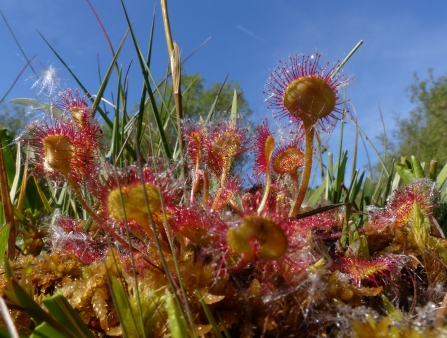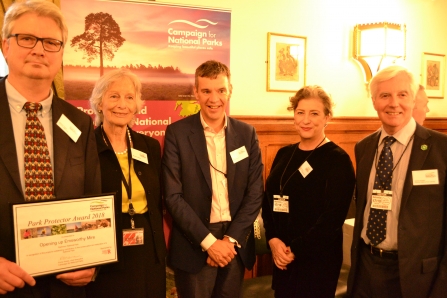
Photo, David Wodehouse
Location
Know before you go
Dogs
When to visit
Opening times
Open at all timesBest time to visit
April to OctoberAbout the reserve
Emsworthy Mire makes a great introduction to Dartmoor. A gently sloping valley leads you down between ancient dry-stone walls to the ruins of a moorland farm, abandoned since the 1870s. In early summer the fields all around are a dazzling purple from the flowers of thousands of bluebells - a stunning sight.
Ash dieback
The disease ash dieback is now widespread in the UK and is present at many of our nature reserves, so we carry out tree felling across our sites in winter months. For your own safety please observe temporary path diversions and closures.
Where possible we will leave affected ash trees in place to decay naturally as an important habitat for wildlife. We plan to only fell diseased ash trees which pose a threat to people or infrastructure. Before trees are felled, we will check whether any rare or protected wildlife is present. If it is, we will postpone or avoid felling these trees. No felling will take place during the bird nesting season.
DWT’s Saving Devon’s Treescapes project are working with communities, landowners and businesses to help make Devon's precious treescapes more resilient in the face of ash dieback. Find out how you can get involved here.
NOTICE: If you are visiting our reserves, please note that there have been instances of H5N1 Avian bird flu found in birds in Devon. There is very low risk to public health, but we do ask that if you come across any unusual or unexplained bird deaths on or near our reserves, please do not touch them and avoid allowing your dog to come into contact with dead birds. Please report them to Defra here or call 03459 335577 and also report your findings to DWT by email at contactus@devonwildlifetrust.org.
Contact us
Location map
How to get to Emsworthy Mire
Take a tour around our beautiful Emsworthy Mire nature reserve in the company of Nick Baker

Meadow pipit feeding a cuckoo at Emsworthy Mire. Photo, John Deakins
A great place to see and hear a cuckoo
Summer birds include tree pipits, redstarts, hobbies, snipe and stonechats. This is also one of the most reliable places to still see and hear cuckoos in the South West. In winter it is golden plovers, fieldfares and redwings that you will spot.
Emsworthy Mire gets its name from its boggy bottom! - an expanse of wet woodland and marshy ground fed by the Becka Brook which runs through the reserve. Don't be put off from exploring. A series of waymarked paths and boardwalks get you close to nature.

Sundew at Emsworthy Mire. Photo, Andrew Taylor
Insect-eating plants and rare butterflies
Plants to look out for include bilberry, cotton grass, orchids and the insect-eating sundew. Toads, frogs and adders also thrive here, as does rare insect life including marsh fritillary butterflies and keeled skimmers.
Emsworthy Mire is great place to begin and end a Dartmoor walk. The popular Haytor and Hound Tor are within reach via a network of paths across classic moorland scenery (check out the Magnificent Mires bog walk from Haytor to Emsworthy here).
Thanks to local volunteers, and grants from the People's Postcode Trust, Viridor Credits Environmental Company and Moor than Meets the Eye there is now a waymarked circular walk around this reserve, and improved access to the Becka Brook.

DWT's Andrew Taylor (furthest left) and Andrew Cooper (furthest right) receive the 2018 Park Protector Award from (middle l to r) Baroness Whitaker, Julian Glover and Caroline Quentin
Emsworthy is a winner!
In October 2018 our work with local volunteers to improve Emsworthy Mire for people and wildlife won the prestigious annual Park Protector Award, given by the Campaign For National Parks.
Find out more about Emsworthy Mire and the things that made it an award winner in this blog by the nature reserve's volunteer warden.
Emsworthy Mire nature reserve leaflet
We've got four other wonderful Dartmoor nature reserves for you to explore.
Become a member and support our work
The vital work we do for nature depends on the support of people who care about the future of Devon’s wildlife and wild places.





